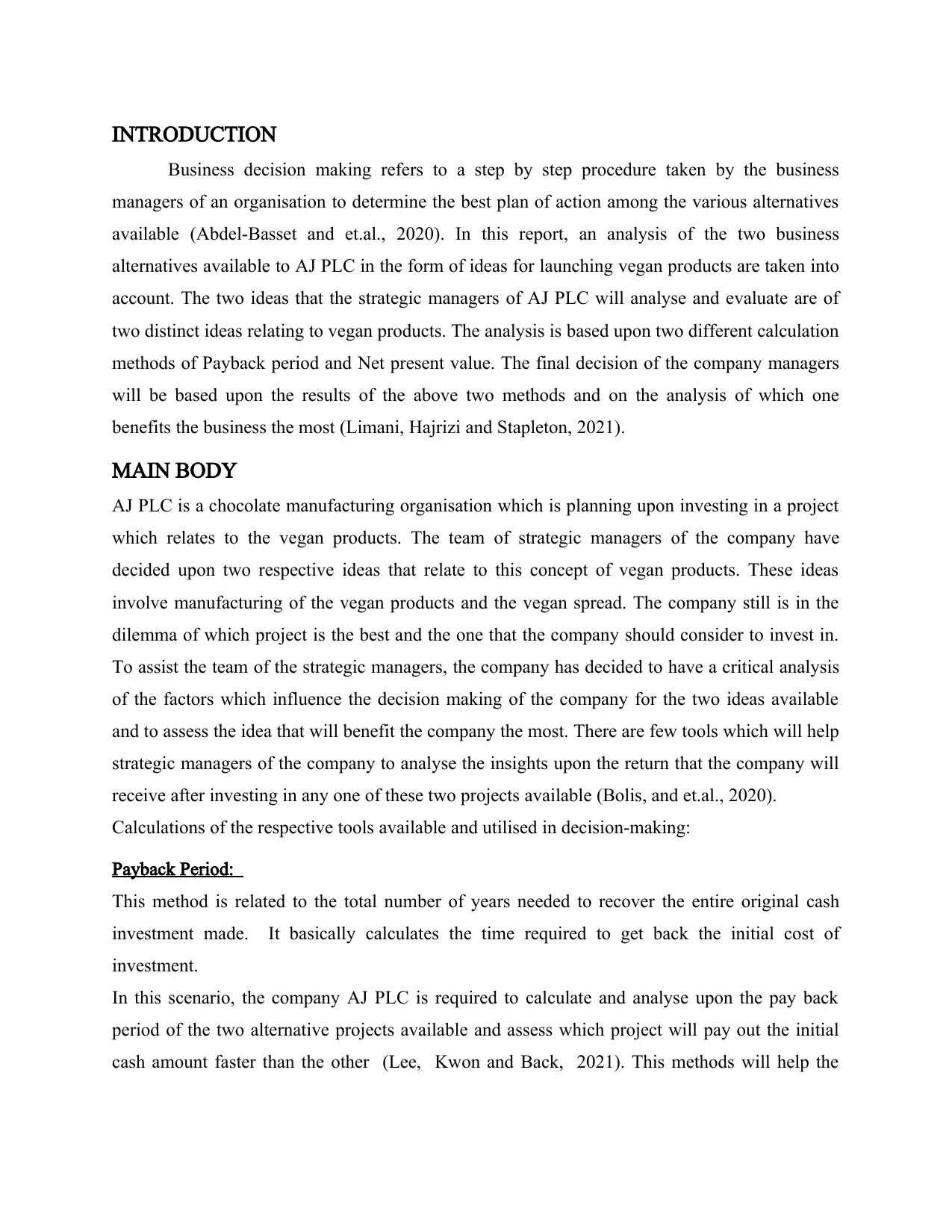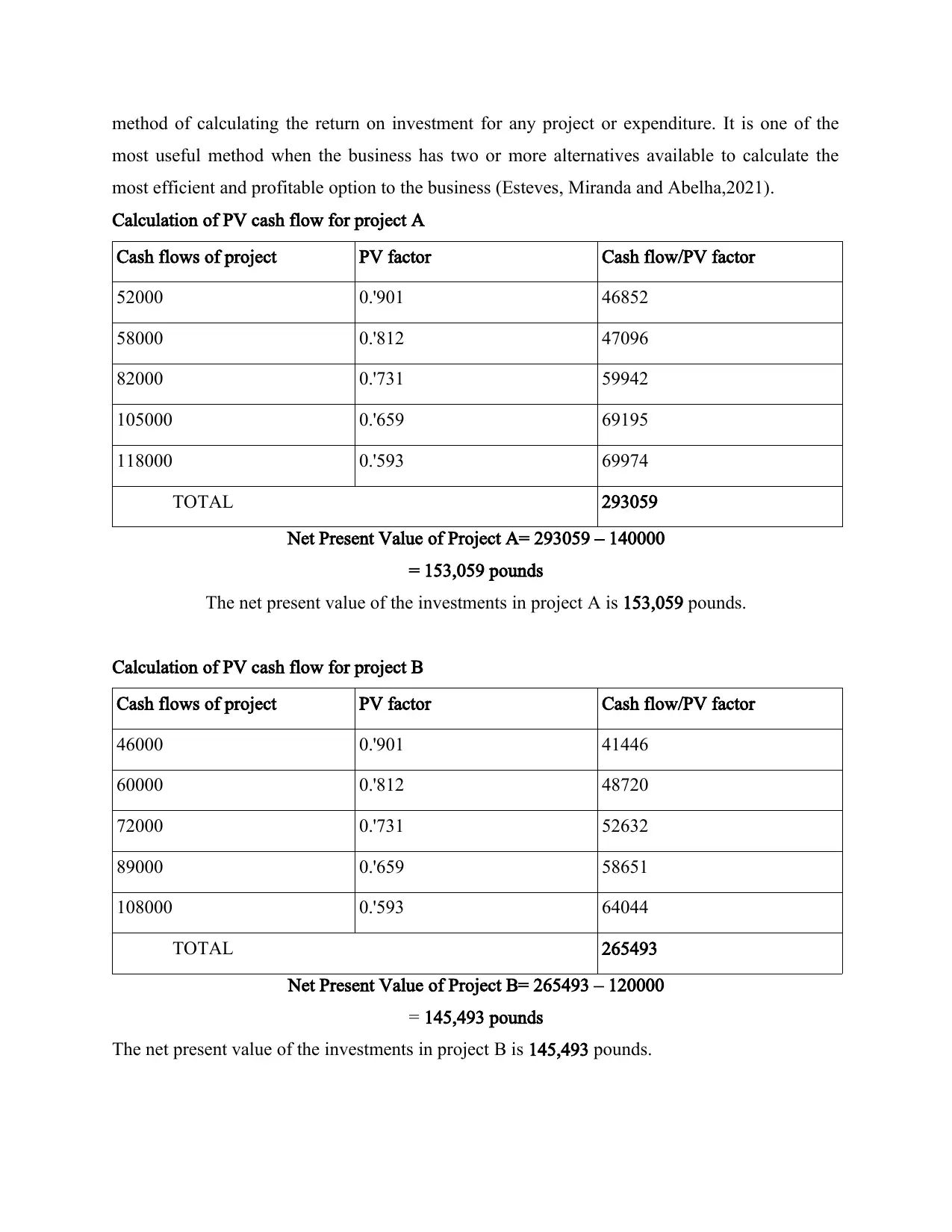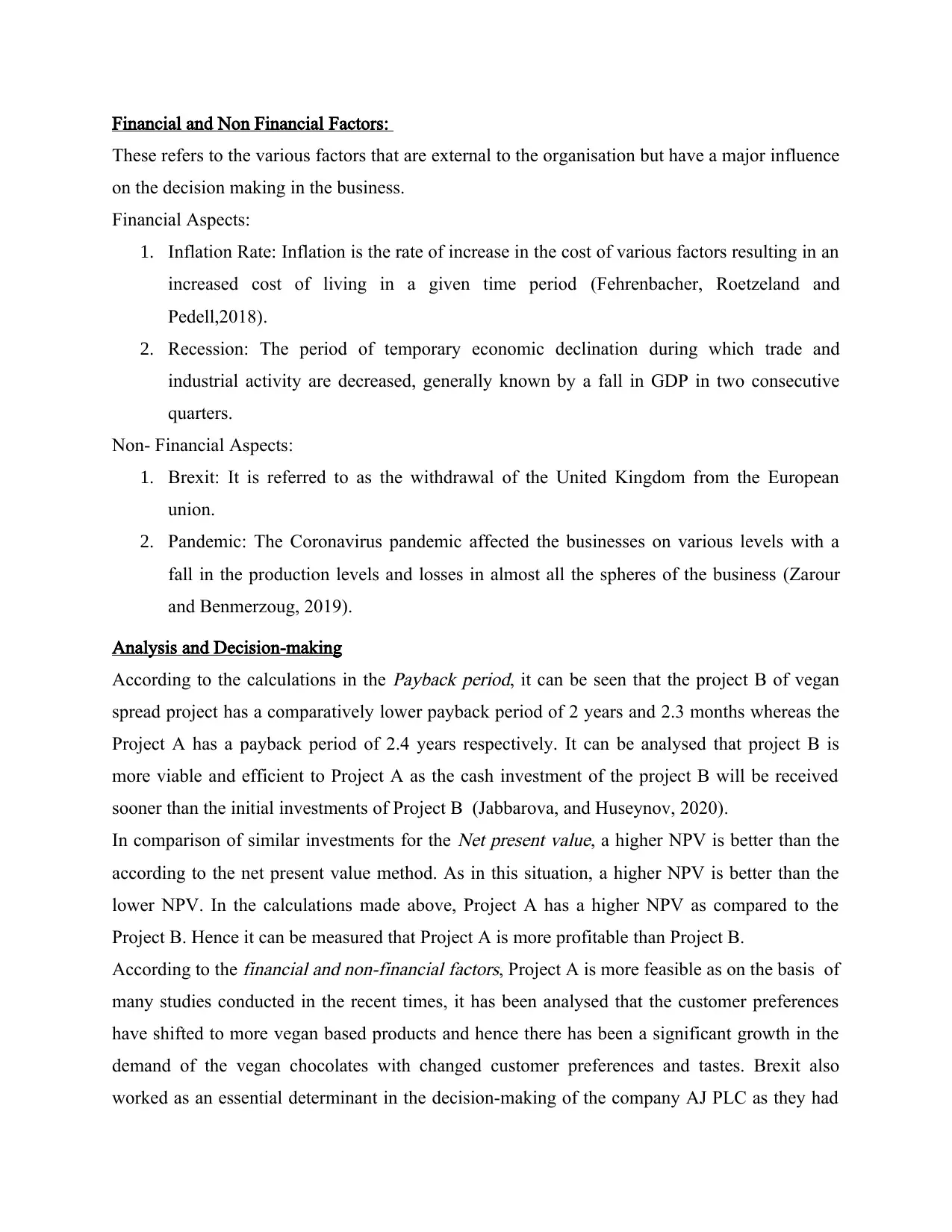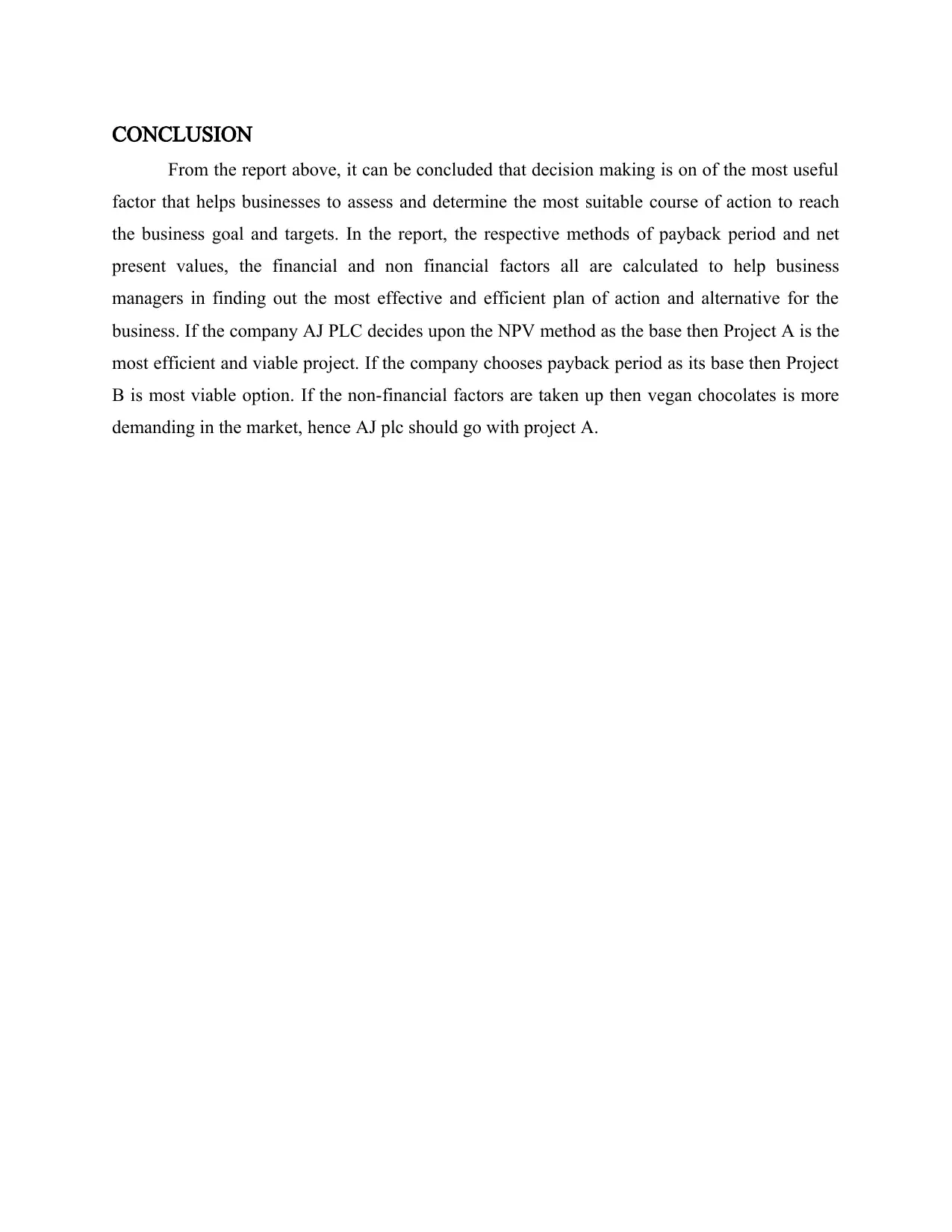Business Decision-Making: Vegan Products Launch Analysis Report
VerifiedAdded on 2023/06/16
|10
|1891
|490
Report
AI Summary
This report provides a comprehensive analysis of two vegan product launch ideas for AJ PLC, utilizing payback period and net present value (NPV) calculations to inform business decision-making. The analysis includes financial factors such as inflation and recession, as well as non-financial factors like Brexit and the pandemic. The payback period calculations show that the vegan spread project (Project B) has a shorter payback period, while the NPV calculations indicate that the vegan chocolate project (Project A) is more profitable. The report also considers the shift in customer preferences towards vegan products and the impact of Brexit on import costs. Ultimately, the decision depends on whether AJ PLC prioritizes a faster return on investment (Project B) or a higher overall profit (Project A), while also considering external market factors and customer demand. Desklib offers a wealth of similar solved assignments and past papers to aid students in their studies.

Business Decision-making
Paraphrase This Document
Need a fresh take? Get an instant paraphrase of this document with our AI Paraphraser

Table of Contents
INTRODUCTION ..........................................................................................................................3
MAIN BODY ..................................................................................................................................3
Payback Period: ....................................................................................................................3
Net Present Value (NPV): .....................................................................................................4
Financial and Non Financial Factors: ....................................................................................5
Analysis and Decision-making...............................................................................................6
CONCLUSION ...............................................................................................................................7
REFERENCES ...............................................................................................................................8
INTRODUCTION ..........................................................................................................................3
MAIN BODY ..................................................................................................................................3
Payback Period: ....................................................................................................................3
Net Present Value (NPV): .....................................................................................................4
Financial and Non Financial Factors: ....................................................................................5
Analysis and Decision-making...............................................................................................6
CONCLUSION ...............................................................................................................................7
REFERENCES ...............................................................................................................................8

INTRODUCTION
Business decision making refers to a step by step procedure taken by the business
managers of an organisation to determine the best plan of action among the various alternatives
available (Abdel-Basset and et.al., 2020). In this report, an analysis of the two business
alternatives available to AJ PLC in the form of ideas for launching vegan products are taken into
account. The two ideas that the strategic managers of AJ PLC will analyse and evaluate are of
two distinct ideas relating to vegan products. The analysis is based upon two different calculation
methods of Payback period and Net present value. The final decision of the company managers
will be based upon the results of the above two methods and on the analysis of which one
benefits the business the most (Limani, Hajrizi and Stapleton, 2021).
MAIN BODY
AJ PLC is a chocolate manufacturing organisation which is planning upon investing in a project
which relates to the vegan products. The team of strategic managers of the company have
decided upon two respective ideas that relate to this concept of vegan products. These ideas
involve manufacturing of the vegan products and the vegan spread. The company still is in the
dilemma of which project is the best and the one that the company should consider to invest in.
To assist the team of the strategic managers, the company has decided to have a critical analysis
of the factors which influence the decision making of the company for the two ideas available
and to assess the idea that will benefit the company the most. There are few tools which will help
strategic managers of the company to analyse the insights upon the return that the company will
receive after investing in any one of these two projects available (Bolis, and et.al., 2020).
Calculations of the respective tools available and utilised in decision-making:
Payback Period:
This method is related to the total number of years needed to recover the entire original cash
investment made. It basically calculates the time required to get back the initial cost of
investment.
In this scenario, the company AJ PLC is required to calculate and analyse upon the pay back
period of the two alternative projects available and assess which project will pay out the initial
cash amount faster than the other (Lee, Kwon and Back, 2021). This methods will help the
Business decision making refers to a step by step procedure taken by the business
managers of an organisation to determine the best plan of action among the various alternatives
available (Abdel-Basset and et.al., 2020). In this report, an analysis of the two business
alternatives available to AJ PLC in the form of ideas for launching vegan products are taken into
account. The two ideas that the strategic managers of AJ PLC will analyse and evaluate are of
two distinct ideas relating to vegan products. The analysis is based upon two different calculation
methods of Payback period and Net present value. The final decision of the company managers
will be based upon the results of the above two methods and on the analysis of which one
benefits the business the most (Limani, Hajrizi and Stapleton, 2021).
MAIN BODY
AJ PLC is a chocolate manufacturing organisation which is planning upon investing in a project
which relates to the vegan products. The team of strategic managers of the company have
decided upon two respective ideas that relate to this concept of vegan products. These ideas
involve manufacturing of the vegan products and the vegan spread. The company still is in the
dilemma of which project is the best and the one that the company should consider to invest in.
To assist the team of the strategic managers, the company has decided to have a critical analysis
of the factors which influence the decision making of the company for the two ideas available
and to assess the idea that will benefit the company the most. There are few tools which will help
strategic managers of the company to analyse the insights upon the return that the company will
receive after investing in any one of these two projects available (Bolis, and et.al., 2020).
Calculations of the respective tools available and utilised in decision-making:
Payback Period:
This method is related to the total number of years needed to recover the entire original cash
investment made. It basically calculates the time required to get back the initial cost of
investment.
In this scenario, the company AJ PLC is required to calculate and analyse upon the pay back
period of the two alternative projects available and assess which project will pay out the initial
cash amount faster than the other (Lee, Kwon and Back, 2021). This methods will help the
⊘ This is a preview!⊘
Do you want full access?
Subscribe today to unlock all pages.

Trusted by 1+ million students worldwide

strategic managers of the business to find out the project which will benefit the business in the
most efficient way as compared to the other.
Year Annual cash flow
of A
Cumulative cash
flow of A
Annual cash flow
of B
Cumulative cash
flow of B
0 (Initial
Investment)
-140000 -140000 -120000 -120000
1 52000 -88000 46000 -74000
2 58000 -30000 60000 -14000
3 82000 52000 72000 58000
4 105000 157000 89000 147000
5 118000 275000 108000 255000
Payback Period = The period up to n-1 + cumulative cash flow in n-1 year / Cash inflow during
the nth year (Zhao and et. al., 2021)
n=year in which cumulative cash flow turned positive
Payback Period of Project A= 2 + 30000 / 82000
= 2 + (0.36*12 months)
= 2+ 4.3
= 2 Years and 4.3 months
Payback period if the company invests in project A is 2 years and 4.3 months.
Payback Period of Project B= 2 + 14000 / 72000
= 2 + (0.19*12 months)
=2 + 2.33
= 2 years and 2.33 months
Payback period if the company invests in project B is 2 years and 2.33 months (Turner,and
Angulo 2018).
Net Present Value (NPV):
Net present value is the method that calculates the present value of all the cash flows at the
required rate of return of the projects as compared to the initial investment. It is basically a
most efficient way as compared to the other.
Year Annual cash flow
of A
Cumulative cash
flow of A
Annual cash flow
of B
Cumulative cash
flow of B
0 (Initial
Investment)
-140000 -140000 -120000 -120000
1 52000 -88000 46000 -74000
2 58000 -30000 60000 -14000
3 82000 52000 72000 58000
4 105000 157000 89000 147000
5 118000 275000 108000 255000
Payback Period = The period up to n-1 + cumulative cash flow in n-1 year / Cash inflow during
the nth year (Zhao and et. al., 2021)
n=year in which cumulative cash flow turned positive
Payback Period of Project A= 2 + 30000 / 82000
= 2 + (0.36*12 months)
= 2+ 4.3
= 2 Years and 4.3 months
Payback period if the company invests in project A is 2 years and 4.3 months.
Payback Period of Project B= 2 + 14000 / 72000
= 2 + (0.19*12 months)
=2 + 2.33
= 2 years and 2.33 months
Payback period if the company invests in project B is 2 years and 2.33 months (Turner,and
Angulo 2018).
Net Present Value (NPV):
Net present value is the method that calculates the present value of all the cash flows at the
required rate of return of the projects as compared to the initial investment. It is basically a
Paraphrase This Document
Need a fresh take? Get an instant paraphrase of this document with our AI Paraphraser

method of calculating the return on investment for any project or expenditure. It is one of the
most useful method when the business has two or more alternatives available to calculate the
most efficient and profitable option to the business (Esteves, Miranda and Abelha,2021).
Calculation of PV cash flow for project A
Cash flows of project PV factor Cash flow/PV factor
52000 0.'901 46852
58000 0.'812 47096
82000 0.'731 59942
105000 0.'659 69195
118000 0.'593 69974
TOTAL 293059
Net Present Value of Project A= 293059 – 140000
= 153,059 pounds
The net present value of the investments in project A is 153,059 pounds.
Calculation of PV cash flow for project B
Cash flows of project PV factor Cash flow/PV factor
46000 0.'901 41446
60000 0.'812 48720
72000 0.'731 52632
89000 0.'659 58651
108000 0.'593 64044
TOTAL 265493
Net Present Value of Project B= 265493 – 120000
= 145,493 pounds
The net present value of the investments in project B is 145,493 pounds.
most useful method when the business has two or more alternatives available to calculate the
most efficient and profitable option to the business (Esteves, Miranda and Abelha,2021).
Calculation of PV cash flow for project A
Cash flows of project PV factor Cash flow/PV factor
52000 0.'901 46852
58000 0.'812 47096
82000 0.'731 59942
105000 0.'659 69195
118000 0.'593 69974
TOTAL 293059
Net Present Value of Project A= 293059 – 140000
= 153,059 pounds
The net present value of the investments in project A is 153,059 pounds.
Calculation of PV cash flow for project B
Cash flows of project PV factor Cash flow/PV factor
46000 0.'901 41446
60000 0.'812 48720
72000 0.'731 52632
89000 0.'659 58651
108000 0.'593 64044
TOTAL 265493
Net Present Value of Project B= 265493 – 120000
= 145,493 pounds
The net present value of the investments in project B is 145,493 pounds.

Financial and Non Financial Factors:
These refers to the various factors that are external to the organisation but have a major influence
on the decision making in the business.
Financial Aspects:
1. Inflation Rate: Inflation is the rate of increase in the cost of various factors resulting in an
increased cost of living in a given time period (Fehrenbacher, Roetzeland and
Pedell,2018).
2. Recession: The period of temporary economic declination during which trade and
industrial activity are decreased, generally known by a fall in GDP in two consecutive
quarters.
Non- Financial Aspects:
1. Brexit: It is referred to as the withdrawal of the United Kingdom from the European
union.
2. Pandemic: The Coronavirus pandemic affected the businesses on various levels with a
fall in the production levels and losses in almost all the spheres of the business (Zarour
and Benmerzoug, 2019).
Analysis and Decision-making
According to the calculations in the
Payback period, it can be seen that the project B of vegan
spread project has a comparatively lower payback period of 2 years and 2.3 months whereas the
Project A has a payback period of 2.4 years respectively. It can be analysed that project B is
more viable and efficient to Project A as the cash investment of the project B will be received
sooner than the initial investments of Project B (Jabbarova, and Huseynov, 2020).
In comparison of similar investments for the
Net present value, a higher NPV is better than the
according to the net present value method. As in this situation, a higher NPV is better than the
lower NPV. In the calculations made above, Project A has a higher NPV as compared to the
Project B. Hence it can be measured that Project A is more profitable than Project B.
According to the
financial and non-financial factors, Project A is more feasible as on the basis of
many studies conducted in the recent times, it has been analysed that the customer preferences
have shifted to more vegan based products and hence there has been a significant growth in the
demand of the vegan chocolates with changed customer preferences and tastes. Brexit also
worked as an essential determinant in the decision-making of the company AJ PLC as they had
These refers to the various factors that are external to the organisation but have a major influence
on the decision making in the business.
Financial Aspects:
1. Inflation Rate: Inflation is the rate of increase in the cost of various factors resulting in an
increased cost of living in a given time period (Fehrenbacher, Roetzeland and
Pedell,2018).
2. Recession: The period of temporary economic declination during which trade and
industrial activity are decreased, generally known by a fall in GDP in two consecutive
quarters.
Non- Financial Aspects:
1. Brexit: It is referred to as the withdrawal of the United Kingdom from the European
union.
2. Pandemic: The Coronavirus pandemic affected the businesses on various levels with a
fall in the production levels and losses in almost all the spheres of the business (Zarour
and Benmerzoug, 2019).
Analysis and Decision-making
According to the calculations in the
Payback period, it can be seen that the project B of vegan
spread project has a comparatively lower payback period of 2 years and 2.3 months whereas the
Project A has a payback period of 2.4 years respectively. It can be analysed that project B is
more viable and efficient to Project A as the cash investment of the project B will be received
sooner than the initial investments of Project B (Jabbarova, and Huseynov, 2020).
In comparison of similar investments for the
Net present value, a higher NPV is better than the
according to the net present value method. As in this situation, a higher NPV is better than the
lower NPV. In the calculations made above, Project A has a higher NPV as compared to the
Project B. Hence it can be measured that Project A is more profitable than Project B.
According to the
financial and non-financial factors, Project A is more feasible as on the basis of
many studies conducted in the recent times, it has been analysed that the customer preferences
have shifted to more vegan based products and hence there has been a significant growth in the
demand of the vegan chocolates with changed customer preferences and tastes. Brexit also
worked as an essential determinant in the decision-making of the company AJ PLC as they had
⊘ This is a preview!⊘
Do you want full access?
Subscribe today to unlock all pages.

Trusted by 1+ million students worldwide

to pay for higher import costs after the Brexit deals and hence an increase in the production costs
(Lakatos, 2020).
(Lakatos, 2020).
Paraphrase This Document
Need a fresh take? Get an instant paraphrase of this document with our AI Paraphraser

CONCLUSION
From the report above, it can be concluded that decision making is on of the most useful
factor that helps businesses to assess and determine the most suitable course of action to reach
the business goal and targets. In the report, the respective methods of payback period and net
present values, the financial and non financial factors all are calculated to help business
managers in finding out the most effective and efficient plan of action and alternative for the
business. If the company AJ PLC decides upon the NPV method as the base then Project A is the
most efficient and viable project. If the company chooses payback period as its base then Project
B is most viable option. If the non-financial factors are taken up then vegan chocolates is more
demanding in the market, hence AJ plc should go with project A.
From the report above, it can be concluded that decision making is on of the most useful
factor that helps businesses to assess and determine the most suitable course of action to reach
the business goal and targets. In the report, the respective methods of payback period and net
present values, the financial and non financial factors all are calculated to help business
managers in finding out the most effective and efficient plan of action and alternative for the
business. If the company AJ PLC decides upon the NPV method as the base then Project A is the
most efficient and viable project. If the company chooses payback period as its base then Project
B is most viable option. If the non-financial factors are taken up then vegan chocolates is more
demanding in the market, hence AJ plc should go with project A.

REFERENCES
Books and Journals
Abdel-Basset, M., and et.al., 2020. A novel decision-making model for sustainable supply chain
finance under uncertainty environment. Journal of Cleaner Production, 269, p.122324.
Bolis, I., and et.al., 2020. The centrality of workers to sustainability based on values: Exploring
ergonomics to introduce new rationalities into decision-making processes. Applied
Ergonomics, 88, p.103148.
Esteves, M., Miranda, F. and Abelha, A., 2021. Pervasive business intelligence platform to
support the decision-making process in waiting lists. In Research Anthology on
Decision Support Systems and Decision Management in Healthcare, Business, and
Engineering (pp. 848-863). IGI Global.
Fehrenbacher, D., Roetzel, P.G. and Pedell, B., 2018. The influence of culture and framing on
investment decision-making: the case of Vietnam and Germany. Cross Cultural &
Strategic Management.
Jabbarova, K. and Huseynov, O.H., 2020, August. Solution of a decision making problem under
risk with z-information. In International Conference on Theory and Applications of
Fuzzy Systems and Soft Computing (pp. 781-786). Springer, Cham.
Lakatos, V., 2020. CONTROLLING TOOLS FOR DECISION-MAKING IN MICRO, SMALL
AND MEDIUM-SIZED ENTERPRISES. Annals of Faculty of Economics, 1(2),
pp.192-203.
Lee, M., Kwon, W. and Back, K.J., 2021. Artificial intelligence for hospitality big data analytics:
developing a prediction model of restaurant review helpfulness for customer decision-
making. International Journal of Contemporary Hospitality Management.
Limani, Y., Hajrizi, E. and Stapleton, L., 2021. Data-Driven Decision-Making Implementation
and Advanced Business Processes in the Digital Age.
Turner, L.A. and Angulo, A.J., 2018. Risky business: An integrated institutional theory for
understanding high-risk decision making in higher education. Harvard Educational
Review, 88(1), pp.53-80.
Zarour, K. and Benmerzoug, D., 2019. A decision-making support for business process
outsourcing to a multi-cloud environment. International Journal of Decision Support
System Technology (IJDSST), 11(1), pp.66-92.
Books and Journals
Abdel-Basset, M., and et.al., 2020. A novel decision-making model for sustainable supply chain
finance under uncertainty environment. Journal of Cleaner Production, 269, p.122324.
Bolis, I., and et.al., 2020. The centrality of workers to sustainability based on values: Exploring
ergonomics to introduce new rationalities into decision-making processes. Applied
Ergonomics, 88, p.103148.
Esteves, M., Miranda, F. and Abelha, A., 2021. Pervasive business intelligence platform to
support the decision-making process in waiting lists. In Research Anthology on
Decision Support Systems and Decision Management in Healthcare, Business, and
Engineering (pp. 848-863). IGI Global.
Fehrenbacher, D., Roetzel, P.G. and Pedell, B., 2018. The influence of culture and framing on
investment decision-making: the case of Vietnam and Germany. Cross Cultural &
Strategic Management.
Jabbarova, K. and Huseynov, O.H., 2020, August. Solution of a decision making problem under
risk with z-information. In International Conference on Theory and Applications of
Fuzzy Systems and Soft Computing (pp. 781-786). Springer, Cham.
Lakatos, V., 2020. CONTROLLING TOOLS FOR DECISION-MAKING IN MICRO, SMALL
AND MEDIUM-SIZED ENTERPRISES. Annals of Faculty of Economics, 1(2),
pp.192-203.
Lee, M., Kwon, W. and Back, K.J., 2021. Artificial intelligence for hospitality big data analytics:
developing a prediction model of restaurant review helpfulness for customer decision-
making. International Journal of Contemporary Hospitality Management.
Limani, Y., Hajrizi, E. and Stapleton, L., 2021. Data-Driven Decision-Making Implementation
and Advanced Business Processes in the Digital Age.
Turner, L.A. and Angulo, A.J., 2018. Risky business: An integrated institutional theory for
understanding high-risk decision making in higher education. Harvard Educational
Review, 88(1), pp.53-80.
Zarour, K. and Benmerzoug, D., 2019. A decision-making support for business process
outsourcing to a multi-cloud environment. International Journal of Decision Support
System Technology (IJDSST), 11(1), pp.66-92.
⊘ This is a preview!⊘
Do you want full access?
Subscribe today to unlock all pages.

Trusted by 1+ million students worldwide

1 out of 10
Related Documents
Your All-in-One AI-Powered Toolkit for Academic Success.
+13062052269
info@desklib.com
Available 24*7 on WhatsApp / Email
![[object Object]](/_next/static/media/star-bottom.7253800d.svg)
Unlock your academic potential
Copyright © 2020–2025 A2Z Services. All Rights Reserved. Developed and managed by ZUCOL.

